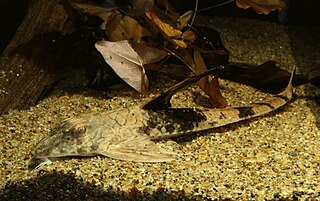
Ancistrus is a genus of nocturnal freshwater fish in the family Loricariidae of order Siluriformes, native to freshwater habitats in South America and Panama. Fish of this genus are common in the aquarium trade where they are known as bushynose or bristlenose catfish. In the aquarium hobby they are often referred to as bushynose or bristlenose plecos instead, but this may lead to confusion as "pleco" usually is used for Hypostomus plecostomus and its allies and is often used as a catchall term for any loricariids remotely resembling that species.

Loricariidae is the largest family of catfish, with 92 genera and just over 680 species. Loricariids originate from freshwater habitats of Costa Rica, Panama, and tropical and subtropical South America. These fish are noted for the bony plates covering their bodies and their suckermouths. Several genera are sold as "plecos", notably the suckermouth catfish, Hypostomus plecostomus, and are popular as aquarium fish.

Loricarioidea is a superfamily of catfishes. It contains the six families Trichomycteridae, Nematogenyiidae, Callichthyidae, Scoloplacidae, Astroblepidae, and Loricariidae. Some schemes also include Amphiliidae. This superfamily, including Amphiliidae, includes about 156 genera and 1,187 species.
Pogonopoma is a genus of armored catfish native to rivers in south and southeast Brazil.
Callichthys serralabium is a tropical freshwater fish belonging to the Callichthyinae sub-family of the family Callichthyidae.

Loricariinae is a subfamily of the family Loricariidae of catfish. This subfamily is divided into two tribes and about 30 genera. They are mainly native to freshwater habitats in South America, but there are also several species in Panama and a single (Fonchiiichthys) in Costa Rica.
Epactionotus is a genus of armored catfishes native to South America.

The Hypoptopomatinae are a subfamily of catfishes of the family Loricariidae, composed of 17 genera and approximately 80 species. This subfamily represents about one-tenth of all loricariid species.
Nannoptopoma is a small genus of catfishes of the family Loricariidae. This genus includes two species, N. spectabile and N. sternoptychum.
Oxyropsis is a genus of fish in the family Loricariidae native to South America. These species are distinguished by the presence of a single row of enlarged odontodes along the trunk midline lying adjacent and immediately dorsal to, the lateral line canal. Species of this genus have a depressed head and have relatively large eyes placed ventrolaterally. This genus is most similar to Hypoptopoma in external appearance, which shares the head shape and eye placement. Oxyropsis are elongate and have a narrow caudal peduncle, which distinguishes it from all other Hypoptopomatinae genera except Niobichthys and Acestridium.
Hisonotus is a genus of armored catfishes native to South America. Species of Hisonotus and Curculionichthys are the only representatives of the subfamily Otothyrinae having serrae on the posterior edge of the pectoral fin spine. These species are small fishes, generally found in small fast flowing streams, where they grasp to the branches and leaves of aquatic or subaquatic plants. The species of this genus mostly occur in Atlantic coastal streams of southern Brazil and the Paraguay-Paraná system of southern South America. They are also distributed in the Río de La Plata basin and coastal rivers of southeastern Brazil.

Parotocinclus is a genus of fish in the family Loricariidae native to South America. This genus is distributed through almost all hydrographic systems in South America from the Guyana Shield drainages and Amazon Shield tributaries to the coastal drainages of eastern and southeastern Brazil, including the rio São Francisco basin. Most species have the caudal peduncle oval in cross section. It has been found that Characidium species may interact with P. maculicauda. The small Characidium will follow grazing P. maculicauda, which release particulate matter dislodged from the catfish's foraging.
Otothyris is a genus of armored catfishes endemic to Brazil.
Paralithoxus is a genus of suckermouth armored catfishes native to tropical South America.
Typhlobelus is a genus of pencil catfishes native to South America.
Pseudolithoxus is a genus of suckermouth armored catfishes with five described species from the basins of the Orinoco, Casiquiare and upper Rio Negro in Venezuela. Additionally, a possibly undescribed species is known from the Trombetas and Nhamundá rivers in Brazil.
Eurycheilichthys limulus is a species of armored catfish endemic to Brazil, where it is found in the upper Jacuí River basin. The habitat at the type locality of E. limulus is a small river about 3–5 metres wide with moderate water current, bottom comprising some rocks but mostly sand and a large amount of marginal vegetation. These fishes live among leaves and stalks. This species grows to a length of 4.8 centimetres (1.9 in) SL.
Eurycheilichthys pantherinus is a species of armored catfish from the upper and middle Uruguay River basin in Brazil and Argentina. It inhabits shady, fast-flowing, shallow water, ranging from approximately 200–500 metres in elevation. The substratum is predominantly stones, with little or no macrophytes. This species grows to a length of 4.2 centimetres (1.7 in) SL.
Yaluwak is a genus of armored catfish native to South America where they are only known from Guyana, containing only a single species Yaluwak primus. It was first described in a 2020 study and placed within the tribe Ancistrini.
Scoloplax dicra is a species of spiny dwarf catfish found throughout the river basins of South America.





